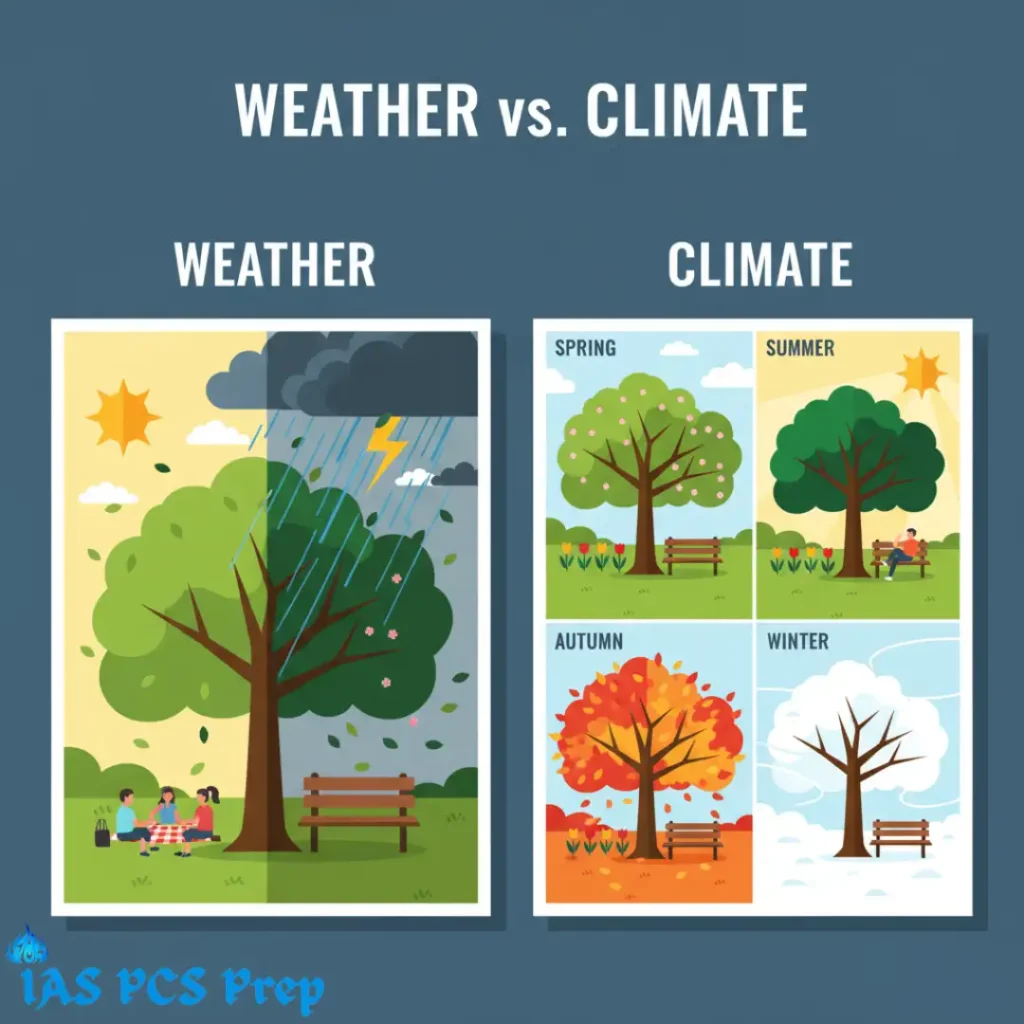Welcome to IAS PCS Prep! Your trusted online platform for UPSC and State PCS exam preparation. At IAS PCS Prep, we provide high-quality study material, notes, and quizzes. Start your preparation on the right track with IAS PCS Prep today.
Daily GS Quiz
Loading…
📖 Topic of the Day
October 15, 2025Weather vs. Climate: Understanding Our Atmosphere
The terms “weather” and “climate” are often used interchangeably, but they refer to fundamentally different concepts. Understanding their distinction is crucial for comprehending everything from daily forecasts to long-term environmental changes. In essence, weather is what you get, while climate is what you expect.
What is Weather?
Weather refers to the state of the atmosphere at a specific time and place. It is a snapshot of short-term conditions, which can change rapidly—from minute to minute, hour to hour, and day to day. When we talk about the weather, we are describing the immediate and temporary atmospheric phenomena we experience.
Key Elements of Weather
Meteorologists measure several key variables to describe the weather:
- Temperature: How hot or cold the air is.
- Precipitation: Water falling from the atmosphere, such as rain, snow, sleet, or hail.
- Humidity: The amount of water vapor in the air.
- Wind Speed and Direction: The movement of air.
- Atmospheric Pressure: The weight of the air pressing down on the Earth’s surface.
- Cloud Cover: The extent of clouds in the sky.
What is Climate?
Climate, on the other hand, describes the long-term average of weather patterns in a particular area, typically over 30 years or more. It tells us what the weather is usually like in a certain region at a certain time of year and includes the variability and frequency of extreme events.
Factors Influencing Climate
A region’s climate is determined by a combination of interacting factors:
- Latitude: The distance from the equator is a primary factor, as it determines the amount of solar energy received.
- Altitude (Elevation): Air becomes thinner and colder at higher elevations, leading to cooler climates in mountainous areas.
- Proximity to Water: Oceans and large lakes moderate temperatures, resulting in cooler summers and milder winters for coastal areas.
- Ocean Currents: These currents transport warm and cold water globally, significantly influencing the climates of adjacent landmasses.
- Topography: Mountain ranges can block air masses, creating wet conditions on the windward side and a dry “rain shadow” on the leeward side.
In summary, weather is the immediate atmospheric condition you experience, while climate is the long-term pattern of weather that characterizes a region. A single cold day in a warm region is just weather; a pattern of consistently warm days and mild winters over many years defines its climate.

Question for you: Why is the climate of London, England, much milder and wetter than that of Calgary, Canada, even though both cities are located at a similar latitude?
Let us know your answer on our social media! 👇
Daily CSAT Quiz
Loading…
Topic Archive
15 Oct 2025
14 Oct 2025
13 Oct 2025
12 Oct 2025
11 Oct 2025
Comprehensive Study Materials
Organised study resources covering all aspects of UPSC CSE preparation from Prelims to Mains.
UPSC CSE Prelims PYPs
Prelims Paper-1 GS Previous Year Papers Prelims Paper-2 CSAT Previous Year PapersEssay Papers
Mains Essay Previous Year PapersGeneral Studies Papers
GS-1 Previous Year Papers GS-2 Previous Year Papers GS-3 Previous Year Papers GS-4 Previous Year PapersOptional Papers
Optional Subject Previous Year PapersStandard Books
Essential Standard Books for UPSC CSENCERT Resources
Role of NCERT Books in UPSC CSE preparationDownload Prelims PYPs
Complete collection of Prelims papers
2013-2025Download Mains Essay PYPs
Essay papers
2013-2025Download Mains GS-1 PYPs
General Studies Paper 1
2013-2025Download Mains GS-2 PYPs
General Studies Paper 2
2013-2025Download Mains GS-3 PYPs
General Studies Paper 3
2013-2025Download Mains GS-4 PYPs
Ethics and Integrity
Optional Paper PYPs (2013-2024)
Optional Paper-1 PYPs
Optional Paper-2 PYPs
Find What You’re Looking For
Search through our comprehensive collection of study materials


